Marie Henriette of Austria
Archduchess Marie Henriette of Austria (Marie Henriette Anne; 23 August 1836 – 19 September 1902) was Queen of the Belgians as the wife of King Leopold II.
| Marie Henriette of Austria | |||||
|---|---|---|---|---|---|
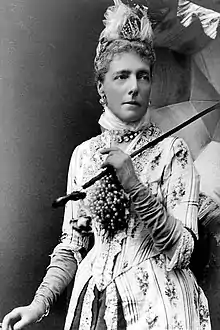 | |||||
| Queen consort of the Belgians | |||||
| Tenure | 10 December 1865 – 19 September 1902 | ||||
| Born | 23 August 1836 Buda Castle, Buda, Kingdom of Hungary, Austrian Empire | ||||
| Died | 19 September 1902 (aged 66) Hôtel du Midi,[1] Spa, Belgium | ||||
| Spouse | |||||
| Issue | |||||
| |||||
| House | Habsburg-Lorraine | ||||
| Father | Archduke Joseph, Palatine of Hungary | ||||
| Mother | Duchess Maria Dorothea of Württemberg | ||||
| Religion | Roman Catholicism | ||||
Marie Henriette was one of five children from the marriage of Archduke Joseph, Palatine of Hungary, and Duchess Maria Dorothea of Württemberg. Marie Henriette was a cousin of Emperor Ferdinand I of Austria, and granddaughter of Leopold II, Holy Roman Emperor, through her father. She was also first cousin to the future Queen Mary of the United Kingdom through her mother.
Marriage and issue
One day before her 17th birthday, she married 18-year-old Prince Leopold of Belgium, the heir to the throne, on 22 August 1853. Leopold was the second-surviving son of Leopold I of Belgium and his French wife, Louise of Orléans; Marie Henriette was the sister-in-law of Charlotte of Belgium, future Empress of Mexico and a cousin by marriage to Victoria of the United Kingdom and Maria II of Portugal.
The marriage was arranged to strengthen the status of the Belgian Monarchy. As the former Protestant monarch of a newly established monarchy, the Belgian king wished his son to marry a member from a Roman Catholic and prestigious dynasty, and the name Habsburg was one of her more important qualities. Henriette was a vivid and energetic person interested in riding. Pauline de Metternich wrote that theirs was a marriage "between a stable-boy and a nun, and by nun I mean the Duke of Brabant". Henriette is said to have had a terrible temperament. The marriage became unhappy, and the couple lived more or less separate lives. She became queen in 1865. After the death of their son in 1869, the couple separated completely after having made a last attempt to have another son, which, however, resulted in their daughter Clementine. She gave her daughters a very strict upbringing. Her main interest was in her Hungarian horses. She lived most of her life unhappy and discontented. In 1895 she retreated to Spa; her youngest daughter Clementine replaced her as first lady at the Court in Brussels for the remainder of her husband's life.
Marie Henriette died at the Hôtel du Midi in Spa; she had bought the house in 1895 after separating with her husband. She was buried in the Royal Crypt at the Church of Our Lady of Laeken in Brussels. Her husband later married (though illegally under Belgian law) his mistress Caroline Delacroix.
Issue
- Princess Louise of Belgium (1858–1924) married to Prince Philipp of Saxe-Coburg and Gotha
- Prince Léopold, Duke of Brabant (1859–1869); died young;
- Princess Stéphanie of Belgium (1864–1945) married to Prince Rudolf, Crown Prince of Austria, son of Franz Joseph I of Austria and Elisabeth of Bavaria;
- Princess Clémentine of Belgium (1872–1955) married to Prince Victor, Prince Napoléon
Honours
She received the following awards:[2]
.svg.png.webp) Austria-Hungary: Dame of the Order of the Starry Cross, 1st Class
Austria-Hungary: Dame of the Order of the Starry Cross, 1st Class.svg.png.webp) Kingdom of Bavaria: Dame of the Order of St. Michael
Kingdom of Bavaria: Dame of the Order of St. Michael.svg.png.webp) Belgium: Grand Cordon of the Order of Leopold
Belgium: Grand Cordon of the Order of Leopold.svg.png.webp) Mexican Empire: Dame Grand Cross of the Order of St. Charles, 10 April 1865[3]
Mexican Empire: Dame Grand Cross of the Order of St. Charles, 10 April 1865[3] Persian Empire: Order of the Sun, 1st Class, 17 June 1873[4]
Persian Empire: Order of the Sun, 1st Class, 17 June 1873[4].svg.png.webp) Kingdom of Portugal: Dame of the Order of Queen Saint Isabel, 5 August 1854[5]
Kingdom of Portugal: Dame of the Order of Queen Saint Isabel, 5 August 1854[5].svg.png.webp) Kingdom of Prussia: Dame of the Order of Louise, 1st Class
Kingdom of Prussia: Dame of the Order of Louise, 1st Class.svg.png.webp) Kingdom of Saxony: Dame of the Order of Sidonia, 1871[6]
Kingdom of Saxony: Dame of the Order of Sidonia, 1871[6].svg.png.webp) Spain: Dame of the Order of Queen Maria Luisa, 6 April 1863[7]
Spain: Dame of the Order of Queen Maria Luisa, 6 April 1863[7].svg.png.webp) Holy See: Golden Rose, 1893 – gift of Pope Leo XIII
Holy See: Golden Rose, 1893 – gift of Pope Leo XIII United Kingdom: Royal Order of Victoria and Albert, 1st Class, 1878[8]
United Kingdom: Royal Order of Victoria and Albert, 1st Class, 1878[8]
Arms
 Alliance Coat of Arms of King Leopold II
Alliance Coat of Arms of King Leopold II
and Queen Marie Henriette of Belgium Royal Monogram of Queen Marie-Henriette
Royal Monogram of Queen Marie-Henriette
of Belgium
Gallery
 Archduchess Marie Henriette of Austria, 1850s
Archduchess Marie Henriette of Austria, 1850s Marie Henriette of Belgium, early 1860s
Marie Henriette of Belgium, early 1860s.jpg.webp) The Queen consort of the Belgians by Franz Xaver Winterhalter, crica 1865
The Queen consort of the Belgians by Franz Xaver Winterhalter, crica 1865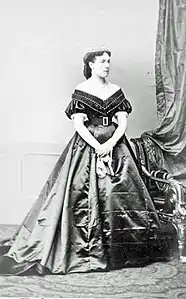 Marie Henriette of Austria, Queen of the Belgians, circa 1867
Marie Henriette of Austria, Queen of the Belgians, circa 1867 Portrait of Queen Marie Henriette (1870s)
Portrait of Queen Marie Henriette (1870s)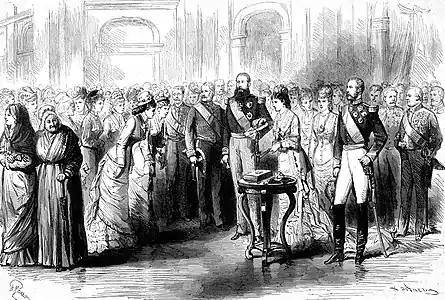 Twenty-fifth wedding anniversary of King Leopold II and Queen Marie-Henriette, Royal Palace (Brussels), 22 August 1878.
Twenty-fifth wedding anniversary of King Leopold II and Queen Marie-Henriette, Royal Palace (Brussels), 22 August 1878.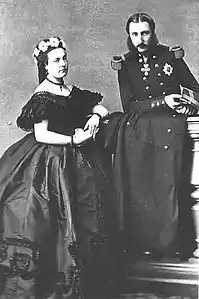 Marie Henriette and Leopold II of Belgium
Marie Henriette and Leopold II of Belgium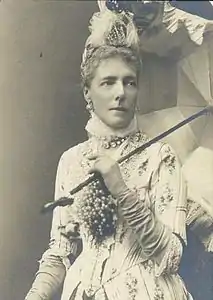 Queen Marie Henriette in middle age, 1875
Queen Marie Henriette in middle age, 1875
Ancestry
| Ancestors of Marie Henriette of Austria |
|---|
References
- sparealites.com
- Almanach royal officiel: 1877. 1877. p. 13.
- "Soberanas y princesas condecoradas con la Gran Cruz de San Carlos el 10 de Abril de 1865" (PDF), Diario del Imperio (in Spanish), National Digital Newspaper Library of Mexico: 347, retrieved 14 November 2020
- Naser al-Din Shah Qajar (1874). "Chapter III: Prussia, Germany, Belgium". The Diary of H.M. The Shah of Persia during his tour through Europe in A.D. 1873: A verbatim translation. Translated by James Redhouse. London: John Murray. p. 135.
- Bragança, Jose Vicente de (2014). "Agraciamentos Portugueses Aos Príncipes da Casa Saxe-Coburgo-Gota" [Portuguese Honours awarded to Princes of the House of Saxe-Coburg and Gotha]. Pro Phalaris (in Portuguese). 9–10: 10. Retrieved 28 November 2019.
- Staatshandbuch für den Freistaat Sachsen: 1873. Heinrich. 1873. p. 155.
- "Real orden de Damas Nobles de la Reina Maria Luisa". Guía Oficial de España (in Spanish). 1900. p. 184. Retrieved 21 March 2019.
- Joseph Whitaker (1897). An Almanack for the Year of Our Lord ... J. Whitaker. p. 110.
External links
 Media related to Marie Henriette of Austria at Wikimedia Commons
Media related to Marie Henriette of Austria at Wikimedia Commons
Marie Henriette of Austria Born: 23 August 1836 Died: 19 September 1902 | ||
| Belgian royalty | ||
|---|---|---|
| Vacant Title last held by Princess Louise of Orléans |
Queen consort of the Belgians 1865–1902 |
Vacant Title next held by Duchess Elisabeth of Bavaria |